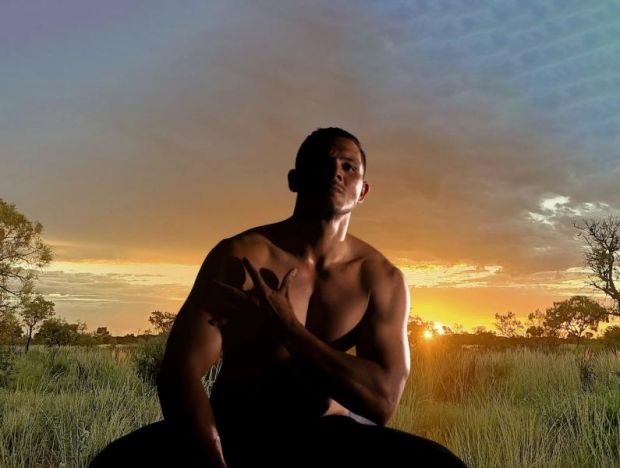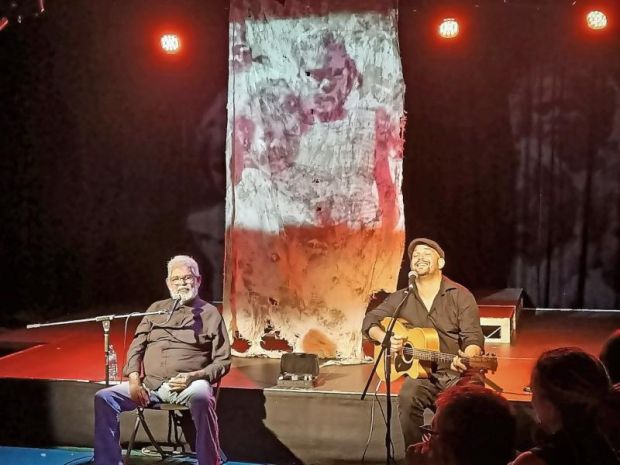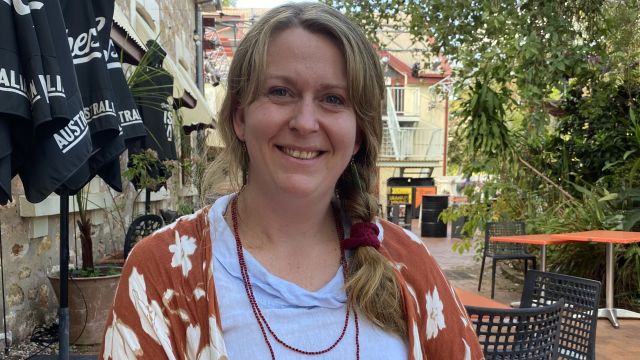Everyone … everywhere
Elizabeth ‘Liz’ Rogers – an ambitious young gun, independent creative producer, director, and maker based in Darwin, who has helped raise over $2.6m through funding, sell-off fees, and philanthropic support for artists in the Northern Territory – sat down with Geoffrey Williams in the courtyard of Darwin’s Brown’s Mart Theatre to laugh a lot, and talk about love, healing, and trust.
GW: So how did you find yourself here in the Territory?
ER: Well, I was born in Darwin, and raised here, between Darwin and Borroloola Robinson River area, which is remote NT. At the age of 18, I went to Sydney to study drama production at university, and then I came back 10 years later because I’d fallen in love with someone here.
GW: A love story! Which university was it?
ER: It was a very small one called the Wesley Institute.
GW: Is it still going?
ER: Yes, under a new name – Excelsior. They had an overview course … production, lighting, sound, set design, writing, direction, and stage management.
GW: When did the theatre bug bite?
ER: I would say from the age of four, I was like, “I’m going to be an actor!”. But I’d look at all the lighting and sound people in their bio box going, “Gee, they look cool … but that’s not my job. I'll do the acting.” And then in my gap year, I auditioned for a role in a musical with Darwin’s Cavenagh Theatre Company, which no longer exists. They loved the acting, but when I started singing, I saw their faces drop and I was like, “Well, I guess I don’t have the part”. I volunteered to work with their stage manager, and I discovered that with acting, I always loved having the audience … I never liked the rehearsals, but with stage management, I felt, “Wow, rehearsals are fun! Shows are fun!” I discovered how much fun I could have, and I was like, “Well, you know what? I think I ought to do something I’m going to like most of the time – so I had better go to a uni that teaches an overview”.
 Image: The Other Side of Me. Composite photography by Paz Tassone and Elizabeth Rogers.
Image: The Other Side of Me. Composite photography by Paz Tassone and Elizabeth Rogers.
GW: We first met at Artback NT, where you were a creative producer for five years.
How did that opportunity present?
ER: When I left university, I was a stage manager. I thought that was safe, because if you made a mistake, you could potentially kill people with lighting or sound. And I thought, “Yeah, I’ve made a safe choice”, but then I’ve seen that it’s actually quite dangerous as a stage manager too … if you call something wrong and something’s flying in and out of the roof. I did that for about eight years before I could see imbalances with scheduling and thought, “The crew don’t get anywhere near the number of breaks that performers get, so I need to rectify this.” And I thought, “Well, that’s the production manager’s job, so I’ll move into that space”, which is when I started production managing shows. Then I met that guy who brought me back to Darwin. That relationship didn’t work out, but Darwin did! Even so, it took me 10 years to find employment in Darwin, which only happened because of a meeting I had with Sean Pardy, the Artistic Director of Brown’s Mart at that time, who had my CV. He forwarded it to the Darwin Festival where I got a production administrator role in 2015. I arrived at Artback NT because I needed a gap year after the festival. I broke my leg while a festival was on, which was exhausting! So, I had a year off and then I happened to go to a music gig and met Louise Partos, who was the Executive Officer of Artback NT at the time, and Louise said, “I’ve got a job going – apply,” and I was like, “Oh, I’ll take look at your organisation”. My response was, “Whoa! They do so much cool stuff … and yes, I’m applying.” The role required a lot of the production skills that I had, and the new skills I learned were the producing skills. It was quite a lot to learn, but Louise was excellent to learn from.
GW: Is the purpose of Artback NT, essentially, to produce and tour the work of First Nations people?
ER: No, no. The remit was Northern Territory artists … so if anyone had an idea, there was a development pathway for them. Artback NT’s mission is ‘Development and Touring’, so if I could see the potential in an artist that their craft and skill could be developed by putting on their show and touring it locally, then I would come in alongside them. And if I thought there’d be an audience for it … because there’s a million people to support really. It was very hard to choose.
GW: Is it tricky to apply that kind of ‘worthy’ assessment to something that might work here at Brown’s Mart in Darwin City and something that might work in Borroloola?
ER: Well, depending on the show, we would then assess where it would go. There were a number of incredible shows across the Territory … there was a puppet show that we took that had no spoken language in it. So that work, for example, we took quite remote, because quite apart from language, there were also cultural differences between what you might see in Alice Springs or Darwin. “Is there a hospital in remote communities? No,” so a hospital scene is out of a cultural context, but the general gist of the story can still be experienced. Puppets are different … amazing. We would tend to take shows that had less of a reliance on understanding English to more remote places around the NT, but we’d also take those shows all the way through. B2M was probably my largest tour while I was there, which is a Tiwi Islands band who would typically do large, music-focused gigs. When we worked with them, we created a theatrical production where there were visuals behind the performance, as well as a story element to it. We worked with them on costumes and not necessarily set design, but design elements … props that really showed a bit more of what the Tiwi Islands culture was. We toured them to 32 venues around Australia for three months, because there was an appetite for them … but there was an appetite for them overseas before there was an appetite for them around Australia.
GW: Is that common, or common in as much as you have toured to 15 countries?
ER: As a producer, I haven’t created anything that has gone overseas – yet … but I’m working towards it! Every artist, anyone, they all want to tour – “Where do you want to go?” “Everywhere.” “Who’s your audience?” “Everyone.” Declan Furber Gillick, for example, is an incredible artist – a writer and performer – whose Big House Dreaming came to Darwin Festival. He’s an Indigenous man from Alice Springs, but based in Melbourne, and he wrote this incredible play about Indigenous incarceration. Now that work is not actually for Indigenous people because it was very educative … you learned a lot from watching it … and you were hit by it as an audience member. But he was an incredible writer, so I wanted to work out a way to get him into communities as a hero to go, “This is what’s possible with your story”. He’s toured the world, and his work has been touring the festival circuit around Australia. What can he teach others about how to do something like he’s done?
GW: Talk to us about your projects coming up in this year’s Darwin Festival – particularly Gary Lang’s The Other Side of Me, which looks amazing.
ER: It’s incredible, and it’s very different to Gary’s NT Dance Company ensemble-focused work, because it’s two men dancing on stage the entire time. It is based on letters that Gary’s co-collaborator from the UK, Laura Fish, wrote to this man in prison, John. So, the story is that Laura came to Australia, and learned about the Stolen Generations. She was adopted from Jamaica and grew up in Cornwall. When she got back to Australia, she learned that there was a boy who was from the Stolen Generations who grew up around the corner from her. When she tried to find him, she discovered that he was in prison and so she set to writing him. Over the course of about five years in the 90s, they wrote to each other, and she’s got about 30 letters … poems she received from him. And Laura’s been working with the family ever since … she wanted to do something with his story, with the family’s permission. She discovered that ‘writing’ wasn’t enough to convey the depth of the emotion, and that really only dance as a medium could fully convey what this young man expressed through his letters. Now, it’s those letters that form the basis of the inspiration for the work. It’s not word for word … it’s not dot point for dot point, but it is inspired by this young man.
 Image. Kingadong. Photo by Elizabeth Rogers.
Image. Kingadong. Photo by Elizabeth Rogers.
GW: The show you’re producing – Kingadong – is also informed by the Stolen Generations. What’s going on there? Is it because that most Australians, perhaps not First Nations people, are still completely oblivious to the extent of what went on? Even today I read about shocking things that happened to Indigenous families throughout the country.
ER: Right. So, the 70s was the time where it officially stopped as an ‘activity’.
GW: So, what’s the impulse behind Kingadong? Because it’s like The War … people not wanting to talk about it, people being unable to talk about it or …
ER: No. So, David told me, “I want to tell my dad, Frank’s story”. David’s a musician, but he’s been wanting to express stories in other forms … and he particularly wanted to tell Frank’s story. Frank, who grew up in the Litchfield region, is the son of a Marrathiel, Marranunggu woman [for whom the Litchfield region is her traditional lands], who got married to a white man who was a gold miner. They got married, and that’s unusual in itself. They got married because David’s grandfather wanted to protect the children, because even at that time they were Wards of the State … they weren’t even considered to be his children or even his wife’s children. ‘Kingadong’ is the name of the beautiful place that their home is on. And when Frank’s mother, David’s grandmother, died, that was the turning point. Frank’s father, who loved them very much, wanted to do what was right for them … with their education and give them a good future … and did what he thought was best and put them into Retta Dixon [an institution for Aboriginal children in Darwin from 1946 until 1982]. And as we may or may not know, it has recently come out that there was some horrible things that happened in there*. However, Frank has done some inspirational things and his children are incredible people. David wanted to celebrate what his father had done, and what his father is still capable of doing, and inspire his father to say, “No, you know, you've got a lot to give still”. Initially, when we set out working on it, David said, “I don't really know if he's going to want to do it because I really irritate him sometimes!” And I replied, “Well, let’s see how that goes.” Last year we worked on it and did a showing with Frank and an invited audience, and the audience responded with, “Well, yeah, we want to see this”, and Frank said, “Yeah, I want to do it. So, then we’re like, “OK, are you sure? Because if you go into the Festival, there’s no turning back … we can’t pull it from the program.” And Frank said, “Yes!”. There was also some friction within the greater family who said, “It sounds like it’s so personal … it’s Frank’s story, but it's impacted the whole family” … so he’s copped a bit of flack, but it’s his story, and Frank said, “I’m telling my story”. Frank was also a musician when he was younger, and that was his way being allowed to leave Retta Dixon … as a teenager … that was how he was able to leave without being watched, without being stuck behind those walls. He can play the didgeridoo, guitar, and mouth organ. He taught his children how to be musicians as well and had bands back in the day. So, we’ve got Frank, whose story it is, and we’ve got his son David, and then we’ve also got Michael, his other son, who’s now performing on stage. And we’ve got Louie, who was an old bandmate of Frank’s back in the day … we’re flying him over from Cairns. So, there’s this incredible richness of what’s happening on stage and who’s there supporting him to tell an eye-opening story of what the Darwin was like in the 60s. It’s really interesting, however, how much we can convey in 60 minutes, we’ve yet to see! I’m quite excited by that, and they’re quite excited about that too.
GW: There must be a very high level of trust … I mean even before they walk into the room, let alone sit down and share intimate details about their lives with you?
ER: I’m not just producing the work, I’m in the room with them suggesting ideas, and sometimes there’s tears, and you listen and just hold space … I mean, I cry with them, often. Especially work that involves a process of healing … there has to be tears.
GW: So how do you choose your projects?
ER: An artist comes to me and tells me their idea, and if I’m like “Woah! Inside, It’s just ‘Yes!’”. With David, there have been so many times when he says to me, “Will this be interesting to other people?”, and I’m like “Yes! Yes, it will!” We might not all be from the Stolen Generations, but it is a human experience to have to recover from something as well. We can’t possibly have the same experience, but there are always experiences we need to heal from.
* Allegations of child sexual abuse at the Retta Dixon Home were investigated at the Royal Commission into Institutional Responses to Child Sexual Abuse in 2015. Ten former residents gave evidence, describing their experiences of rape, molestation, and abuse at the home. The findings released on 19 August 2015, found that Australian Indigenous Ministries (AIM) “… did not meet the obligations that it had to children in its care, including protection from sexual abuse”. The Commissioners found that AIM did not provide sufficient training to its staff on how to detect or respond to allegations of child sexual abuse. As a result of an out-of-court settlement, 71 people were awarded compensation in 2017. As of September 2021, a least ten people had applied for compensation under the Australian Government’s National Redress Scheme (NRS), which was set up for people who have experienced institutional child abuse. However, the government prevented AIM from being a participant in the NRS, for the stated reason that the group could not afford to pay out potential claimants. There was a possibility that funding could be drawn from a government body, as a “funder of last resort”, during the 2021 review of the scheme. Claimants and the AIM were exploring ways in which AIM could make a meaningful apology to survivors of abuse suffered at the home. In September 2021, a civil lawsuit brought by a man in his 50s against AIM and the Commonwealth in 2020 for abuse suffered by him at the home was concluded, with compensation paid after agreement was reached in a court-ordered mediation process.
The Other Side of Me, Wednesday 9–Saturday 12 August, Studio Theatre, Darwin Entertainment Centre, as part of the 2023 Darwin Festival. You can find out more about The Other Side of Me and book tickets here:
https://www.darwinfestival.org.au/events/the-other-side-of-me
Kingadon, Friday 25–Sunday 27 August 2023, at Brown’s Mart Studio, as part of the 2023 Darwin Festival. You can find out more about Kingadon and book tickets here:
https://www.darwinfestival.org.au/events/kingadong
Find out more about Elizabeth Rogers here: https://www.elizabethrogers.com.au/about
Find out more about the 2023 Darwin Festival program here:
https://www.darwinfestival.org.au
You can read Geoffrey Williams’ article for Stage Whispers about Darwin’s musical theatre powerhouse – Superstar Productions – recent production of Evita here:
https://www.stagewhispers.com.au/community-theatre/evita-comes-darwin
Subscribe to our E-Newsletter, buy our latest print edition or find a Performing Arts book at Book Nook.

